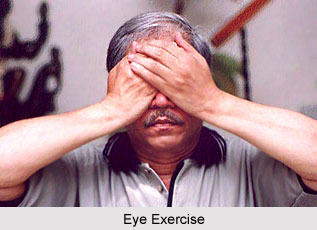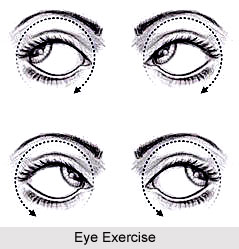Eyes are a pair of integral organs in human body that requires proper exercise to work efficiently throughout the lifetime. The eyes work all the time and is under constant strain. The only time the eyes attain rest is while slumber. Perhaps the three most common defects of eyesight are myopia (short-sightedness), hypermetropia (long-sightedness) and presbyopia (failing eyesight due to age). Yoga has proved its efficiency in treating eye problems as well. Most of the Yogic eye exercises are very easy to do and they can be performed during any hour of the day.
Some of the Yoga exercises for eyes are as follows -
•One should close the eyes as tight as possible, for around 5 seconds, then open them, and close them again. This should be done for 6 times.
•If the job of a person requires him/her to sit in front of computer for long, one should get up every half an hour from in front of the screen and move around a bit.
•One should shut the eyes and roll the eyeballs around for a minute.
• Rubbing the palms together and gently cupping them over the closed eyes for around a minute is beneficial for the eyes. This process is known as palming and reflects the idea that the eyes need darkness to rejuvenate them and this need is best served by palming. Palming should be done after every eye exercise, to relax the eyes and every now and then during the day.
Rubbing the palms together and gently cupping them over the closed eyes for around a minute is beneficial for the eyes. This process is known as palming and reflects the idea that the eyes need darkness to rejuvenate them and this need is best served by palming. Palming should be done after every eye exercise, to relax the eyes and every now and then during the day.
•One should imagine that there is a huge clock in front and he/she should look at the number 12 for around 10 seconds, and then move the gaze down to 6. This should be done for around 10 times, rapidly. Then, one should move the eyes horizontally, in the 3-9 position. Finally, one should move them diagonally.
•The individual can look up to the position in the middle of the eyebrows. Hold for a few seconds and then move the gaze downwards, towards the nose. This is called Sambhavi mudra.
•Slowly, directing the gaze to the ceiling, as one inhale and then exhaling and moving the gaze down in a straight line, towards the floor greatly exercises the eyes. This should be done approximately 6 times.
•Any form of physical exercise, including walking, reduces pressure on the eyeballs and is beneficial for the eyes.
•Blinking lubricates the eyes. But sometimes, when the person is concentrating hard, he/she tends to blink less and eventually makes a conscious effort to blink more.
•Dim the lights are preferable in the workplace. Bright lights increases eye strain.
•While working on computer, it is best to reduce the brightness of the computer. The eyes can adjust to dim light without too much of strain.
•While sitting in a room by the window, and focusing on a point in the distance, one should hold the arm straight out in front, in the same direction as the point one is focusing on, with the thumb extended in a `thumbs-up` position. The thumb should be directly in the line of vision of the object the person is focusing on in the distance. One should keep shifting the focus from the thumb to the point in the distance. This exercise should be done around ten times, and at least once a day.
• One should slowly roll the eyes first clockwise, then counterclockwise as follows: Lowering the eyes and looking at the floor, then slowly moving the eyes to the left, higher and higher until one can see the ceiling. Continuing and circling the vision to the right, lowering and lowering down, until one can see the floor again. One should do this slowly, making a full-vision circle. Then, one should close the eyes and rest. Then repeat the same action counterclockwise.
One should slowly roll the eyes first clockwise, then counterclockwise as follows: Lowering the eyes and looking at the floor, then slowly moving the eyes to the left, higher and higher until one can see the ceiling. Continuing and circling the vision to the right, lowering and lowering down, until one can see the floor again. One should do this slowly, making a full-vision circle. Then, one should close the eyes and rest. Then repeat the same action counterclockwise.
Jal neti (nasal irrigation with water) keeps the sinuses, nasal tract and the throat free from infection. This, in turn, keeps the eyes free from congestion and strain, thus improving vision. Practicing nadi shodhan (alternate breathing) pranayama is very effective to improve eyesight. One should always start and end with the left nostril. Vajrasana, Padmasana or Siddhasana has positive effects on defective eyesight.
The yoga practitioners declare special importance to eye exercises, for two reasons. Firstly, people face immense eye problems in later life due to the loss of tone in the eye muscles. These muscles often become rigid, and this loss of elasticity reduces the ability of the lens of the eye to focus at different distances. Thus this also causes the eyesight to become weaker. These exercises tone the eye muscles up and keep them elastic.
Secondly, the prevailing eye tension will tend to produce a general feeling of tension, due to the eye`s connection to the brain through the optic nerve. The eye tension produces an increase in the nerve impulses in the eye muscles. This increase in nerve impulses traveling along the optic nerve and bombards with the brain, thus causing a general feeling of tension and anxiety. The eye exercises will reduce tension in the eye muscles, as well as reduce general tension. It is best to do these eye exercises while lying down after finishing the asanas. This way the person is resting after the asanas and doing the eye exercises at the same time, thus reducing the time taken to do the yoga routine. When doing the eye exercises one should keep the eyes open and keep the head static.
The Yogic eye exercises helps to do away with eye strain, and tension. The person`s vision will get better and clearer as the ophthalmic nerves receive a richer supply of blood. There are many causes for poor vision like malnutrition, faulty reading posture, insufficient light, mental strain, Stiff neck and shoulder muscles and many more. Besides, practicing exercises, one should also look into the above areas of consideration. Yoga offers a host of corrective measures for defective eyesight.
DISCLAIMER - The Yoga asanas prescribed above should be strictly performed under the supervision of an experienced Yoga teacher.



